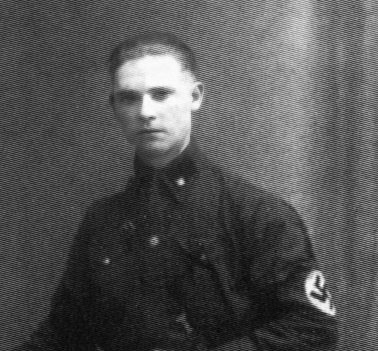
Blood Martyrs of the National Socialist Movement
The Year 1930
Edmund Behnke
(*30 December 1906, † 16 March 1930 in Berlin)

Edmund Behnke was a resistance fighter against the Weimar Republic and a Blood martyr to the National Socialist movement.
„For all of you“ - this inscription was on the gravestone of a man who was one of the first in the Reich capital to declare his support for Adolf Hitler, the SS man Edmund Behnke from Berlin. Born in the borderland of Bromberg, he became acquainted with the hardships of the Fatherland in his early youth. Driven out of his German hometown of Bromberg with his parents by Poles who had occupied this part of Germany, he grew up partly in a refugee camp in Mecklenburg.
He joins the Freikorps Roßbach and with his comrades waits in vain on 9 November 1923 for the signal to march on Berlin. Since Die Saat is not yet ripe, Edmund Behnke continues to fight tirelessly for the movement. A happy hour for him was when he was able to shake hands with Adolf Hitler on his first visit to Berlin in a small circle of loyal followers. At every National Socialist rally, the handsome SS man takes over the hall guard, feared by the Reds who get to know his fists. After a meeting in the Pharussälen on 11 February 1927, Edmund Behnke is attacked and severely beaten up by a Communist superior force. The injuries do not heal, the fatal swelling of the brain remains undetected for too long. Slowly they erode the strength of his body. Suffering severely and feeling his end approaching, his only hot wish is to be able to look the Führer in the eye once more. This wish is fulfilled at the 1929 Reich Party Congress in Nuremberg. The deterioration of his powers continues. The loyal fighter goes blind, his right side is completely paralysed. On 16 March 1930, death delivered him. Dr Goebbels gave the eulogy.
Kurt Günther
(*23 June 1904, † 16 March 1930 in Chemnitz)

Kurt Günther was a resistance fighter against the Weimar Republic and a Blood martyr of the National Socialist movement.
The carpenter Kurt Günther joined the NSDAP in 1926. In the same year, he became a member of the SA.
On 16 March 1930, the National Socialists of Chemnitz held a rally against the adoption of the Young Plan.
The Reichsbanner and Red Front took to the streets to oppose the rally. Adolf Hitler’s men marched, regardless of the raging mob. In the long army of Brown Shirts marched a small band of SA men who had come over from Einsiedel. More than a hundred communists attacked them in Fritz-Reuter-Strasse, murdering hatefully with knives and daggers. SA Scharführer Kurt Günther falls with a pierced heart and ends his life with the last words:
„Heil Adolf Hitler!
Paul Kessler
(date of birth unknown - † 24. 3. 1930)
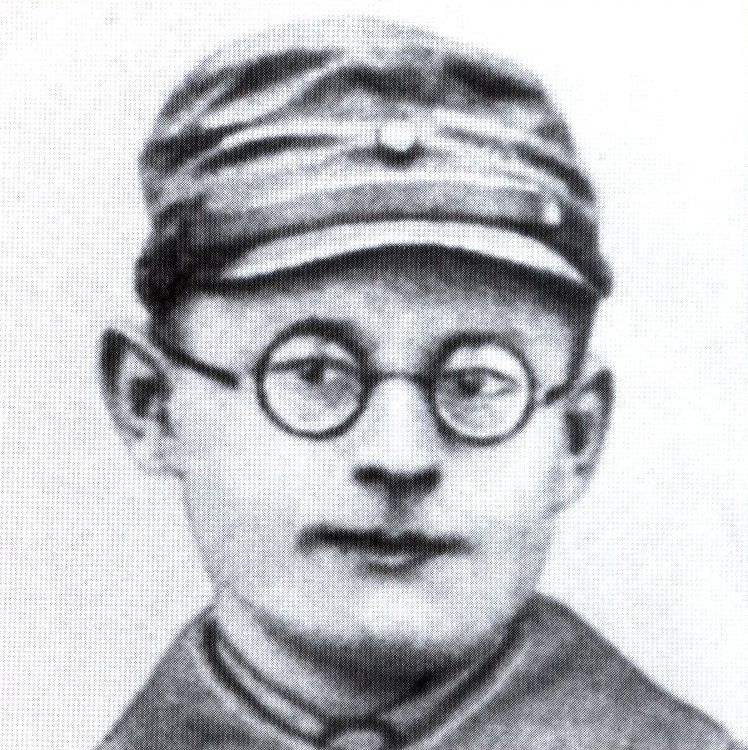
In many lists of the NSDAP, the Hamburg Blood martyr Paul Keßler remains unnamed.
The young man, described by his comrades as quiet and unassuming, came from Berlin and belonged to the unit there that Horst Wessel had led.
In Hamburg, he worked for the party as propaganda leader of the NSDAP section in the Borgfelde district and wore the collar patches of SA Storm 6/76.
On 11 January, Kessler belonged to a glue group that was attacked by communists. The attackers inflict the most severe skull injuries on him with a dustbin. The other SA men first carry Kessler to the Quandt storm pub to treat him there.
A short time later, the arriving doctor arranges for his immediate transfer to a hospital. The young Hamburg SA man dies three months later as a result of the head injuries.
In March 1934, the city of Hamburg renames Hasencleverstrasse and Geibstrasse Paul-Kessler-Strasse.
Franz Engel
(* 18 May 1912, † 12 May 1930 in Stargard)

Franz Engel was a resistance fighter against the Weimar Republic and a Blood martyr of the National Socialist movement.
Property dies, clans die, you die like them.
One thing I know, that the glory of the dead lives forever
This saying from the Edda was inscribed on the monument of the SA man Franz Engel, who worked as a welder in Stargard. On the evening of 11 May 1930, he was shot in the head during a communist attack. He was part of an escort team for a comrade and his daughter. Franz Engel died of his injuries the following day. Engel was a former communist and fell victim to an assassination attempt by former comrades. Of the perpetrators, one, Müller, received four years in prison, while the communist city councillor Koltermann was acquitted.
Barely a month before the crime, the teacher and Reichsbanner leader Radke had given an incendiary speech against the National Socialists in which he called for the streets of Stargard to be cleansed of the National Socialist pest by all means, as Der Angriff of 15 May 1930 reported.
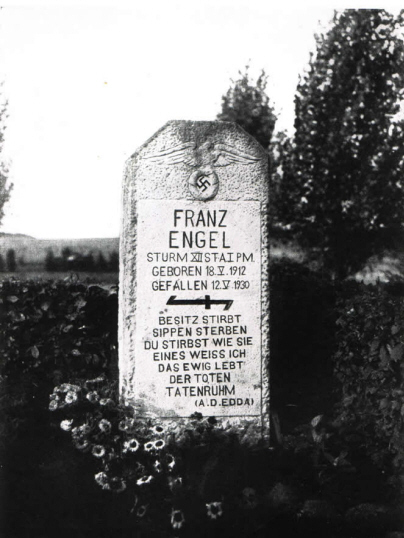
In Stargard, Franz Engel Street was named after him.
Heinrich Messerschmidt
(*5 February 1874, † 27 July 1930 in Kassel)

Heinrich Messerschmidt was a resistance fighter against the Weimar Republic and a Blood martyr to the National Socialist movement.
A self-sacrificing sense of duty characterised the tireless work in the movement of the National Socialist Heinrich Messerschmidt from Kassel. Even at the age of fifty-six, the upright man gave all his creative energy to the party, and the trust of his fellow citizens made him a city councillor of Kassel. On 18 June 1930 Heinrich Messerschmidt chaired an election meeting in Kassel. Pursued by the furious hatred of the communists, the intrepid fighter was attacked by a gang of murderers on his way home and wounded by numerous knife wounds, which brought about his death on 27 July 1930.
In the meeting of the city council of 23 June 1930, Roland Freisler raises the massive accusation against the Kassel police chief Dr. Adolf Hohenstein („the Jewish former lawyer“) and the police lieutenant colonel Otto Schulz („the social democratic commander of the protective police“) that they had wanted to „see blood flowing“ in the streets of the city on 18 June.
Adalbert Schwarz
(*13. 3. 1906 - † 3. 8. 1930)
District Vienna, Vienna SA Group
Adalbert Schwarz was born the son of a machine fitter in Gmünd, Austria. On 2 August 1930, the SA man of the Vienna Storm 23/4 took part with other comrades in an SA concert of the Vienna 1 Standarte.
The locksmith’s assistant had already joined the party in 1927.
All press reports write of a concert by the „Vaterländischer Schutzbund“.
This was the organisation that had combined the structures of the SA and SS in Austria since 1923.
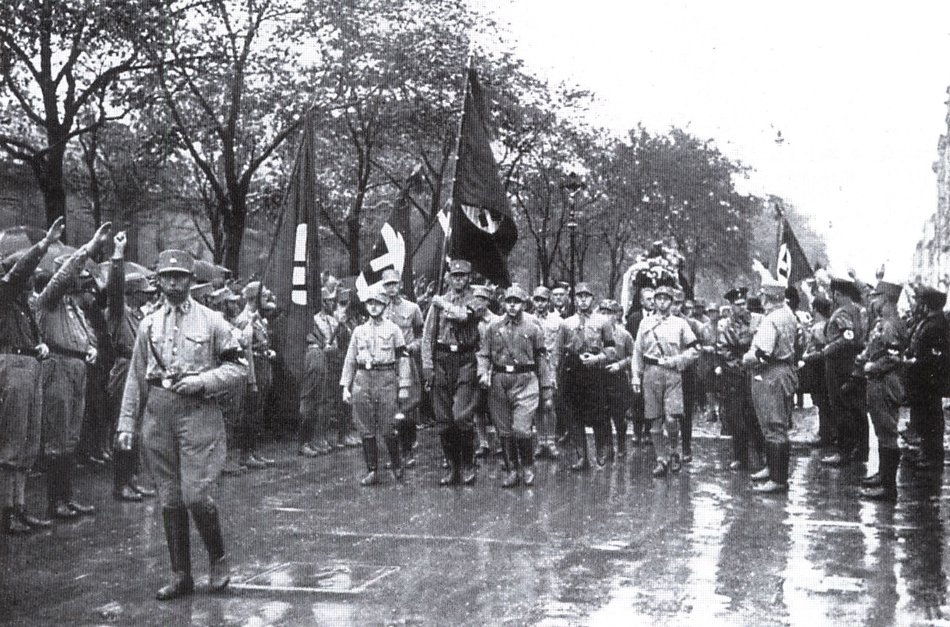
The last escort for the murdered Adalbert Schwarz
The details of the confrontation are described in the police report printed by the „Wiener Sonn- und Montags-Zeitung“ in its issue of 4 August 1930:
„On the evening of 2 March, a concert of the association Vaterländischer Schutzbund took place in the restaurant Altes Währinger Brauhaus, 18th district, Gentzgasse 62. After this concert, at about 12 o’clock at night, two members of the Vaterländischer Schutzbund, the 24-year-old locksmith’s assistant Adalbert Schwarz, 17th district, Hemalser Hauptstraße 14, and his brother, the 23-year-old electrician’s assistant Anton Schwarz, 18th district, Schumanngasse 11, were standing in front of this inn. When the two Schwarz brothers rejected these remarks, one of the boys, the 20-year-old labourer Eduard Prinz, 17. district, Lacknerg. 44, first punched Adalbert Schwarz with his fist and then stabbed him in the left side of the chest with his pocket knife. The two boys then fled, but were pursued by Anton Schwarz, the journeyman carpenter Josef Schwarz and several other patrons of the pub. When Anton Schwarz had caught up with Prinz, Prinz slightly injured him with his knife on the ring finger of his left hand. Josef Schwarz was considerably injured with a switchblade knife on his right upper and lower arm by Prinz’s companion, 19-year-old labourer Johann Kirchmeyer, 17th district, Nesselgasse 9b resident. Rushing security guards joined in the pursuit. The two boys were finally stopped and handed over to the Währing police station.
Adalbert Schwarz, who in the meantime had collapsed unconscious, was taken to the first casualty ward of the General Hospital by the Vienna Volunteer Rescue Society, where he died after being handed over. [...]“
The extent to which the crime had a political background was contradictorily presented.
It is certain that the victim was a member of the NSDAP and wore the brown shirt during the attack. While the Catholic-oriented newspaper „Reichspost“ wrote on 3 August 1930 of the main perpetrator, Prinz, as a „known, fierce political opponent of the Vaterländischer Schutzbund“, other reports vehemently denied the political motive.
The perpetrator allegedly made the derogatory statement that led to the bloody confrontation only with regard to his girlfriend, whom he did not want to attend the so-called „widows’ balls“ that also took place in the „Alter Währinger Grenzhaus“.
The SA storm 23/4 „Adalbert Schwarz“ was named after the „First Blood martyr of the Ostmark“.
Günther Wolf
(*24 May 1909, † 3 August 1930 in Beuthen, Upper Silesia)
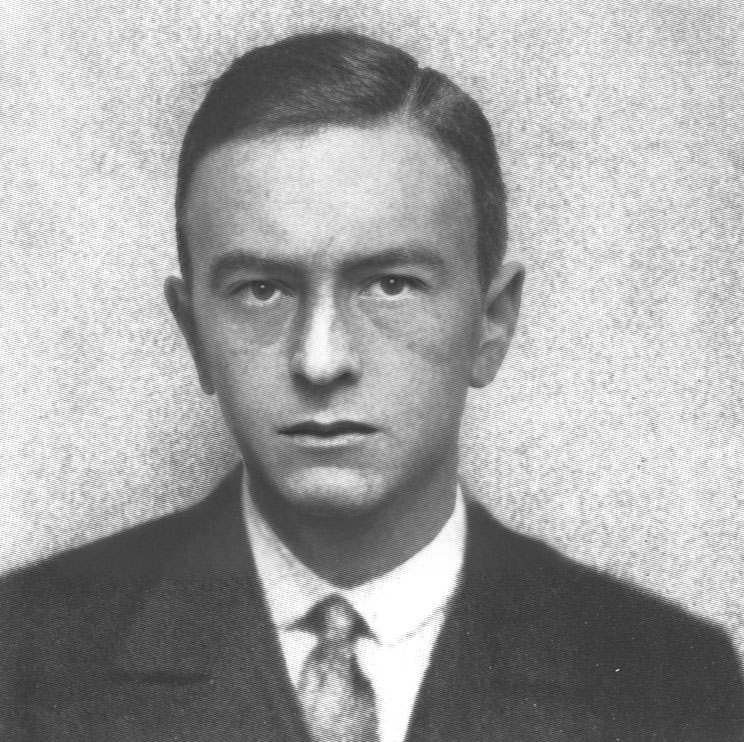
Günther Wolf was a resistance fighter against the Weimar Republic and a Blood martyr of the National Socialist movement.
In 1929, the budding architect joined the NSDAP and the SA.
On 3 August 1930, the SA man Günther Wolf from Beuthen in Upper Silesia was with comrades in an NSDAP bonding column. At night, in the darkness, a horde of communist murderers set upon the brown fighters. With unheard-of brutality, the Red superiority beat the small band of Hitler men. Günther Wolf bled to death with a torn carotid artery.
Karl Paas
(*29 July 1889, † 9 August 1930)

Karl Paas was a resistance fighter against the Weimar Republic and a Blood martyr of the National Socialist movement.
On 8 August 1930, a National Socialist meeting took place in Haan near Solingen, attended by SA men who had come over from Solingen in a truck. During the meeting, communists crept up to the vehicle and loosened the side wall bolts and fastenings. When after the end of the rally the SA men got back into the truck and drove off, the communists pelted them with a hail of stones and bottles. The red attackers hung on to the tailgate of the truck and beat the SA with clubs. Suddenly the side wall broke during the journey and the Brown Shirts fell onto Haaner Schillerstrasse. The SA Scharführer Karl Paas, a metal worker from Solingen, flag bearer in Traditionssturm 54 of Standarte XV, suffered a skull injury in the fall, which he succumbed to on 9 August 1930.
In the newly built settlement of Neuss-Reuschenberg, a street was named after him in December 1937.
On 9 November 1938, a funeral service was held in Erkrath for the SS man Kurt Hilmer, who died there in 1932. A large Haan delegation took part. The people of Haan also commemorated the SA man Karl Paas from Gräfrath who died on Schillerstraße in 1930. In the evening, the local NSDAP group met at the Windhövel Hotel, and the Hitler Youth also commemorated the martyrs.
Heinrich Dreckmann
(*11 October 1885, † 7 September 1930 in Hamburg)

Heinrich Dreckmann was a resistance fighter against the Weimar Republic and a Blood martyr to the National Socialist movement.
Adolf Hitler spoke in Hamburg on 6 September 1930. A new election was coming up. The next day, a Sunday, the Hamburg SA organised a propaganda march. Squad leader Heinrich Dreckmann says simply to his wife and daughter as he bids them farewell: „It’s not for us, it’s for Germany.“ The Senate had banned a closed parade by the SA. The Bolshevik hordes gathered near the Sternschanzen railway station and five thousand Reds opposed five hundred SA men. The street battle did not last long before the Brown Shirts had put the tenfold superiority of the Reds to flight. Many an SA man was bloodied and battered. Only one lay still on the pavement, stabbed to death by a murderer’s hand: Squad leader Heinrich Dreckmann. This „Battle of the Sternschanze“ took place on the corner of Susannenstraße and Schanzenstraße. Susannenstraße in Hamburg’s Sankt Pauli district was later renamed Heinrich-Dreckmann-Straße in memory of the murder.
The SA storm leader Conn reported on this:
„On the corner of Susannenstraße and Schanzenstraße, the deputy troop leader Heinrich Dreckmann of Sturm 50 fell under the knife wounds of Red Front.“
An Alster ship was named after Heinrich Dreckmann, which had to be renamed „Alster“ after the occupation of Germany.
Heinz Oetting
(*7 May 1909, † 11 September 1930)
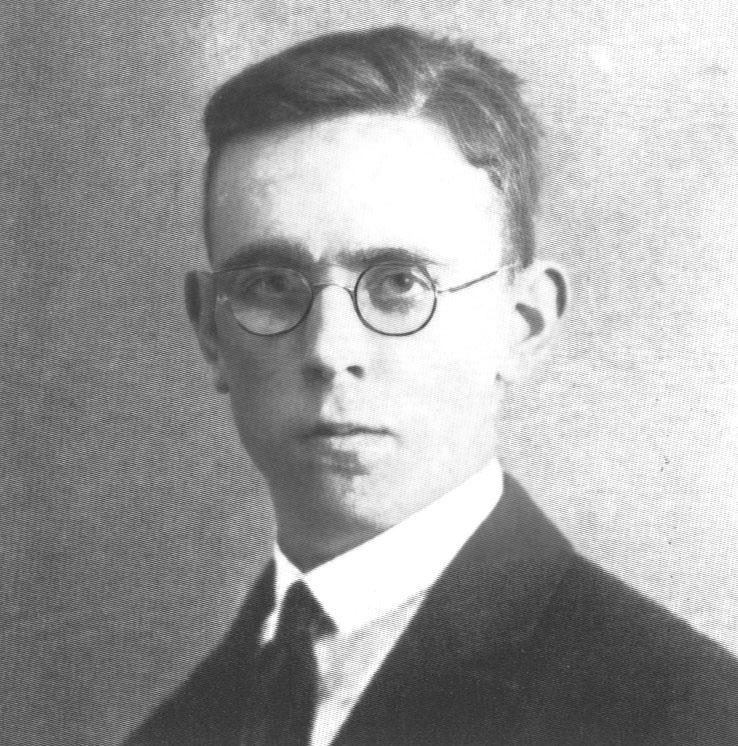
Heinz Oetting was a resistance fighter against the Weimar Republic and a Blood martyr of the National Socialist movement.
The young student of Protestant theology Heinz Oetting was attacked on 10 September 1930 on his way home from a mass NSDAP rally in Essen and died the following day from a stab wound to the right side of his chest.
The Plettenberg home chronicle wrote about the murder:
„The National Socialist student Heinz Oetting, the son of a pastor who had worked in Plettenberg for many years, was stabbed to death by communists after an election meeting.“
Hans Kießling
(* 14 June 1904, † 12 September 1930)

Hans Kiessling was a resistance fighter against the Weimar Republic and a Blood martyr to the National Socialist movement.
On 12 September 1930, the opening of the Hotel Döbraberg in Schwarzenbach am Wald was attended by the National Socialist factory worker Hans Kiessling. As he left the pub after midnight, a communist worker shouted at him, „You Nazi!“ Ignoring the shouter, Kiessling continued on his way. The communist followed him and after a short exchange of words plunged his knife into his heart. Hans Kiessling immediately collapsed dead. The murderer was sentenced by the Weimar system justice to two years six months in prison.
Kießlingstraße was named after Hans Kießling in Bayreuth.
Karl Taube
(† 8 October 1930 in Rosenberg, Upper Silesia)

Karl Taube was a resistance fighter against the Weimar Republic and a Blood martyr of the National Socialist movement.
Already during the occupation of Upper Silesia, Karl Taube clashed with the Polish occupiers. He was threatened with being shot. Only his father saved him from certain death.
Around midnight on 8 October 1930, the SA man Karl Taube was attacked in the darkness of a courtyard corner by the communist Sittko, who had a criminal record, and fatally injured by stabbing him in the carotid artery. After nine months in prison, the murderer was released by the Weimar system of justice.

Memorial stone for Karl Taube, Rosenberg (Upper Silesia),
Fallen on 18 October 1930
Schillstrasse was renamed Karl-Taube-Strasse in honour of the murdered man.
Josef Hilmerich
(*19 February 1905, † 21 November 1930 in Düsseldorf)
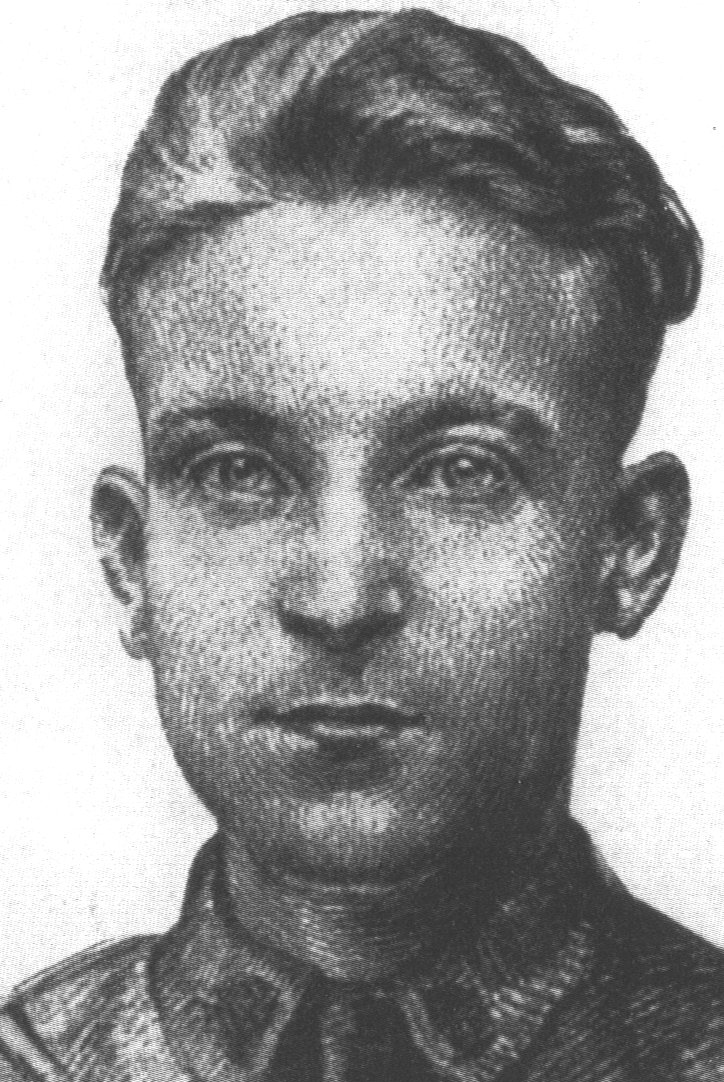
Josef Hilmerich was a resistance fighter against the Weimar Republic and a Blood martyr of the National Socialist movement.
On the wall of the house at Immermannstrasse 2a in Düsseldorf, the place where the locksmith and SA squad leader Josef Hilmerich was shot by communists on 21 November 1930, a commemorative plaque was erected in the Third Reich with the inscription:
At this place fell on 21 November 1930
On Moscow’s orders, the SA. squad leader
Josef Hilmerich in faithful fulfilment of duty
as a fighter for Germany’s rebirth.
A reminder to the young generation!
On 13 March 1936, the Lord Mayor Wilhelm Eberhard Gelberg turned the first sod for the newly created Josef Hilmerich Strasse in Neuss-Reuschenberg.
Theodor Sanders
(*20 May 1909, † 4 December 1930; Hagen (Westphalia))
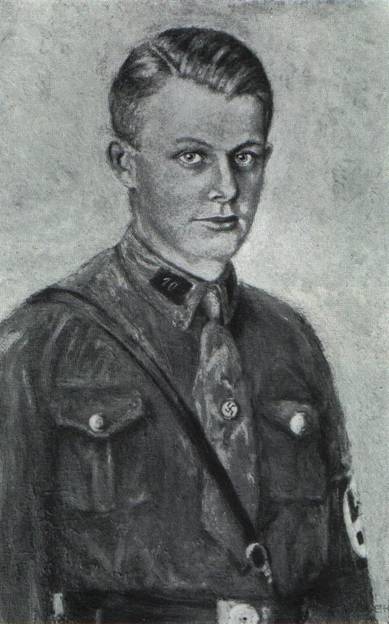
Theodor Sanders was a resistance fighter against the Weimar Republic and a Blood martyr to the National Socialist movement.
On 4 December 1930, the SA. man Theodor Sanders had to end his young life. Two days earlier, on 2 December 1930, as he unsuspectingly rode his bicycle around the corner in bright moonlight, he was torn from his bicycle by two communist murderers and brutalised with murder instruments of all kinds. A rubber hose filled with sand and a saw bayonet with which he is stabbed. He had only recently become a member of the NSDAP and was assigned to Sturm 10 in Hagen, where he fulfilled his duties in an exemplary manner, so that he soon became popular with his comrades. Theodor Sanders dies from the injuries inflicted on him. The trial of the murderers took place in February 1931. A total of eight people were charged, all members of the KPD and the Red Help. The main perpetrator, due to the overwhelming evidence, must be sentenced to nine years in prison.
The street where the murder took place was called Theo-Sanders-Strasse in the Third Reich.
Adolf Höh
(*31 December 1902, † 7 December 1930 in Dortmund)
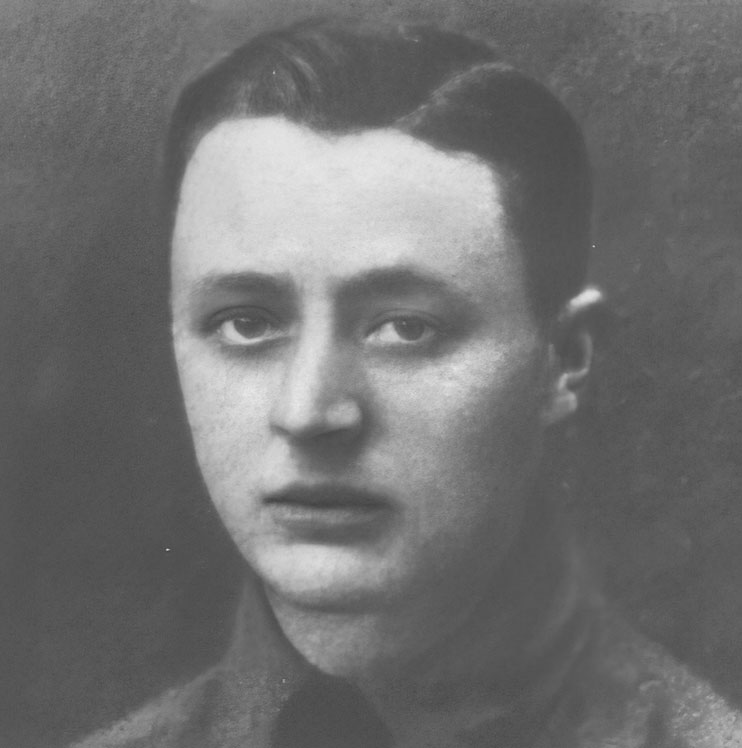
Adolf Höh was a resistance fighter against the Weimar Republic and a Blood martyr of the National Socialist movement.
In 1922, Adolf Höh joined Adolf Hitler’s movement. He had the membership number 3563 of the NSDAP. As a young person, he came from the Rhenish Palatinate to Coburg, where he founded the local group of the NSDAP in Coburg together with the then Chief President of the Province of Pomerania, Pg. Schwede. His life was dedicated to the Führer; personally quiet, modest and unassuming, he was always a model of care and loyalty for his comrades, and a whole man in battle. He promoted his movement in Coburg and the surrounding area, in Upper and Middle Franconia. In 1926, the young engineer moved to Dortmund and from here he continued the struggle in the Ruhr area, in Westphalia and in the northern Rhineland. He was often seriously injured by political opponents, and in the 1930 election campaign communist criminals stabbed him in the head. As a well-known NSDAP militant, he was often severely maltreated by the police with rubber truncheons and repeatedly arrested. However, he was not challenged by this, and with renewed vigour he continued to work for his lofty goal. When he moved to Dortmund, the SA there numbered barely thirty men. Adolf Höh gave it new impetus, new goals, so that it soon gained feared strength. One evening he was leading two comrades home through the darkness. Then shots rang out from hidden corners. A shot to the head knocks Adolf Höh down. For days his tenacious nature wrestled with death. On 7 December 1930, death won.
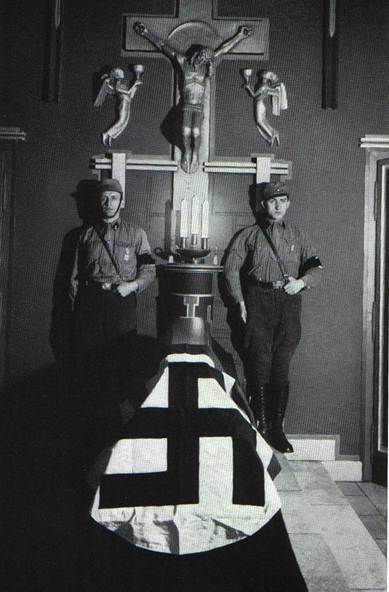
Adolf Höh, Dortmund, killed in action on 7 December 1930.
Laying out in the chapel of the Brüder Hospital, Dortmund
SS. storm 11 in Dortmund bore the name Adolf Höh.
Klaus Clemens
(* 26 February 1907 in Beuel, † 18 December 1930 in Bonn)

Klaus Clemens was a resistance fighter against the Weimar Republic and a Blood martyr to the National Socialist movement.
7 December 1930 in Bonn. A big rally was to take place on a Sunday in the Beethovenhalle. The crowd of active militants in the city and country of Bonn was still small. They are mostly young workers and students. The terror from the Marxist side is excessive. A group of young fighters marched courageously across the Rhine bridge. The swastika banner waved victoriously. Among the marchers is Klaus Clemens, the 23-year-old architect. The eldest, the pride of his parents. Then the red mob breaks in on the unarmed with murder tools. Two shots echo through the winter day. Klaus Clemens collapses with a hit in the forehead. He wrestles with death for several days until 18 December, when he dies at the age of twenty-two. During Christmas week, SA comrades carry him to his grave. The young fighter rests quietly in the village of Küdinghoven, mourned by thousands of comrades and friends. The event went down in German history as „Bloody Sunday in Bonn“. The murderer was the Jew Josef Messinger.
The Bonn youth hostel on the corner of Poppelsdorfer Allee and Quantiusstraße was named after Klaus Clemens in 1933, as were the Klaus Clemens Bridge (Alte Rheinbrücke) and Klaus Clemens Street (Dyroffstraße). In Bad Godesberg, Klaus-Clemens-Straße (Gotenstraße) and in Oberkassel near Bonn, Klaus-Clemens-Straße (Simonstraße) commemorated him. There were also Klaus Clemens Streets in other Rhenish cities, for example in Eschweiler from 31 March 1933 due to a city council resolution.
In Euskirchen, Klaus Clemens was honoured as a „Blood martyr of the movement“ by the fact that a few years later the new housing estate on Frauenbergerstraße, in the immediate vicinity of the cemetery, was named after him. This naming was not officially reversed after the war and the occupation of Germany.
Julius Hollmann
(*1 June 1877, † 22 December 1930 in Bonn)
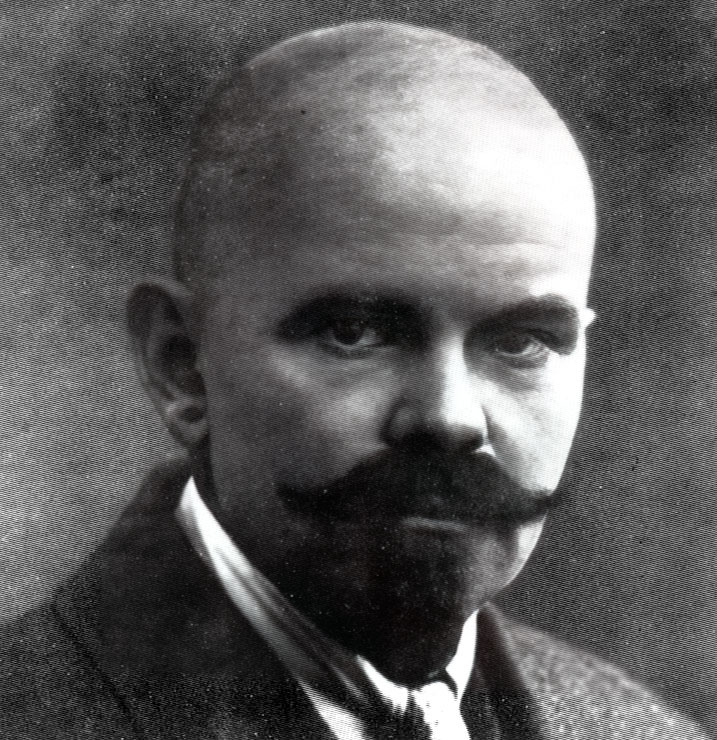
Julius Hollmann was a resistance fighter against the Weimar Republic and a Blood martyr to the National Socialist movement.
SA squad leader Julius Hollmann from Wuppertal-Barmen was a civil engineer and construction foreman and he proudly wore his party and SA badge on the construction sites, because the old China fighter did not fear the scowls of the often communist construction workers. He put many of his SA comrades to work, and he worked sacrificially for the movement. On 16 November 1930, the fifty-three-year-old squad leader was attacked by a superior number of communists, knocked down and kicked with unbelievable brutality, so that he succumbed to his injuries five weeks later on 22 December 1930, three days before Christmas.